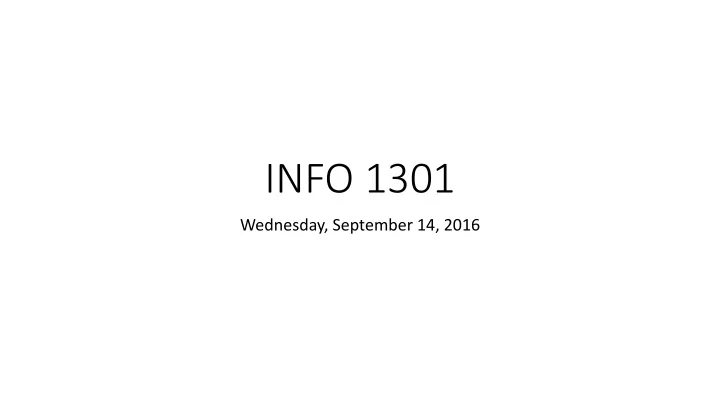

INFO ¡1301 Wednesday, ¡September ¡14, ¡2016
Topics ¡to ¡be ¡covered • Last ¡class ¡we ¡spoke ¡about ¡the ¡middle ¡(central ¡tendency) ¡of ¡a ¡data ¡set. ¡ Today ¡we ¡talk ¡about ¡variability ¡in ¡a ¡data ¡set. • Variability ¡of ¡Data • Variance • Standard ¡Deviation • The ¡math ¡to ¡calculate ¡measures ¡of ¡variability ¡are ¡more ¡tedious ¡than ¡ calculating ¡measures ¡of ¡central ¡tendency, ¡so ¡after ¡doing ¡a ¡bit ¡of ¡ introductory ¡material ¡by ¡hand, ¡we ¡will ¡rely ¡on ¡tools ¡such ¡as ¡Minitab ¡ Express.
Variance • Intuitively, ¡variance ¡is ¡the ¡distance ¡data ¡points ¡vary ¡from ¡the ¡mean ¡for ¡ a ¡data ¡set. • Consider ¡two ¡data ¡sets. • A ¡is ¡4,5,6,7,8 • B ¡is ¡2,4,6,8,10 • The ¡mean ¡is ¡the ¡same ¡in ¡both ¡cases. ¡(What ¡is ¡the ¡mean?) • But ¡you ¡can ¡intuitively ¡say ¡that ¡data ¡set ¡B ¡varies ¡more ¡from ¡its ¡mean ¡ that ¡data ¡set ¡B. • So, ¡however ¡we ¡define ¡variance, ¡it ¡should ¡be ¡higher ¡for ¡data ¡set ¡B ¡than ¡for ¡ data ¡set ¡A.
More ¡about ¡variance • We ¡know ¡how ¡to ¡measure ¡the ¡distance ¡between ¡two ¡points; ¡it ¡is ¡a ¡subtraction. • So, ¡in ¡the ¡case ¡of ¡data ¡set ¡A, ¡the ¡distances ¡of ¡the ¡various ¡points ¡are: ¡ 4-‑6 ¡= ¡-‑2 5-‑6 ¡= ¡-‑1 6-‑6 ¡= ¡0 7-‑6 ¡= ¡1 8-‑6 ¡= ¡2 The ¡ones ¡to ¡the ¡left ¡of ¡the ¡mean ¡yield ¡negative ¡numbers, ¡the ¡ones ¡to ¡the ¡right ¡yield ¡ positive ¡numbers. • But ¡we ¡are ¡interested ¡in ¡measuring ¡the ¡overall ¡distance ¡of ¡the ¡data ¡set ¡from ¡the ¡mean, ¡ not ¡just ¡the ¡distance ¡of ¡each ¡individual ¡data ¡point ¡from ¡the ¡mean. • So ¡we ¡must ¡do ¡something ¡with ¡these ¡individual ¡distances ¡to ¡calculate ¡a ¡single ¡number ¡ that ¡represents ¡the ¡variance ¡of ¡the ¡entire ¡data ¡set.
Even ¡More ¡About ¡Variance • We ¡calculated ¡the ¡mean ¡by ¡adding ¡up ¡the ¡values ¡of ¡the ¡data ¡points ¡ and ¡dividing ¡by ¡the ¡size ¡of ¡the ¡data ¡set. ¡This ¡won’t ¡work ¡with ¡ variance. ¡(Why?) • Do ¡you ¡remember ¡from ¡high ¡school ¡how ¡to ¡calculate ¡the ¡distance ¡ between ¡two ¡points ¡in ¡the ¡x-‑y ¡plane? ¡(Hint: ¡use ¡the ¡Pythagorean ¡ Theorem) • Example: ¡The ¡distance ¡from ¡(1,1) ¡to ¡(4,5). ¡(Hint: ¡Draw ¡the ¡right ¡ triangle ¡and ¡calculate.) • Use ¡this ¡same ¡idea ¡to ¡calculate ¡the ¡variance ¡(from ¡the ¡mean).
Your ¡lucky ¡day ¡– even ¡more ¡about ¡variance! • Process ¡for ¡calculating ¡variance ¡and ¡standard ¡deviation 1. Find ¡the ¡mean 2. Find ¡the ¡difference ¡of ¡the ¡mean ¡from ¡each ¡data ¡point 3. Square ¡each ¡of ¡those ¡differences 4. Add ¡them ¡together 5. Divide ¡by ¡n-‑1 ¡where ¡n ¡is ¡the ¡number ¡of ¡data ¡points ¡in ¡the ¡data ¡set ¡This ¡is ¡ known ¡as ¡the ¡variance and ¡is ¡designated ¡by ¡σ 2 . [ You ¡would ¡think ¡you ¡would ¡ divide ¡by ¡n. ¡However, ¡for ¡reasons ¡that ¡will ¡be ¡explained ¡in ¡a ¡later ¡course, ¡ having ¡to ¡do ¡with ¡the ¡difference ¡between ¡samples ¡and ¡populations, ¡you ¡ divide ¡by ¡n-‑1. You ¡will ¡just ¡have ¡to ¡live ¡with ¡this ¡seeming ¡anomaly ¡for ¡now. ] 6. Take ¡the ¡square ¡root ¡= ¡σ = ¡standard ¡deviation
Variance ¡of ¡Data ¡Set ¡A 1. mean ¡= ¡(4+5+6+7+8)/5 ¡= ¡30/5 ¡= ¡6 2. Difference ¡of ¡mean ¡from ¡each ¡data ¡point: ¡4-‑6=-‑2, ¡5-‑6=-‑1, ¡6-‑6=0, ¡ ¡ ¡ ¡ ¡ ¡ ¡ ¡ ¡ ¡ ¡ ¡ ¡ ¡ 7-‑6=1, ¡8-‑6=2 3. Square ¡of ¡those ¡differences: ¡(-‑2) 2 =4, ¡(-‑1) 2 =1, ¡0 2 =0, ¡1 2 =1, ¡2 2 =4 4. Add ¡them ¡together: ¡4+1+0+1+4=10 5. Divide ¡by ¡n-‑1: ¡10/(5-‑1)=2.5 ¡= ¡σ 2 ¡ ¡ (variance) 6. Square ¡root: ¡(2.5) .5 = ¡approximately ¡1.6 ¡= ¡σ (standard ¡deviation) Your ¡turn: ¡calculate ¡the ¡variance ¡and ¡standard ¡deviation ¡for ¡data ¡set ¡B. How ¡does ¡it ¡compare ¡to ¡the ¡variance ¡for ¡data ¡set ¡A?
Standard ¡Deviation • The ¡standard ¡deviation ¡is ¡a ¡measure ¡of ¡how ¡close ¡the ¡data ¡is ¡to ¡the ¡ mean • Often ¡– but ¡not ¡always! ¡– 70% ¡of ¡the ¡data ¡will ¡be ¡within ¡one ¡standard ¡ deviation ¡of ¡the ¡mean. • In ¡Data ¡set ¡A, ¡the ¡mean ¡is ¡6 ¡and ¡the ¡standard ¡deviation ¡is ¡ approximately ¡1.6. ¡So, ¡data ¡points ¡5,6,7 ¡are ¡within ¡the ¡standard ¡ deviation; ¡data ¡points ¡4,8 ¡are ¡not. ¡So, ¡60% ¡within ¡1 ¡σ. • Often ¡– but ¡not ¡always! ¡– 95% ¡of ¡the ¡data ¡points ¡within ¡2 σ. ¡ • In ¡Data ¡set ¡A, ¡the ¡mean ¡is ¡6 ¡and ¡2 σ = ¡3.2. ¡All ¡5 ¡data ¡points ¡– or ¡100% ¡ -‑ within ¡2 σ.
In-‑class ¡Exercise How ¡do ¡the ¡Rockies ¡compare? ¡Assign ¡each ¡person ¡a ¡team. • Go ¡to ¡the ¡mlb.com site, ¡choose ¡statistics, ¡choose ¡which ¡team, ¡click ¡on ¡AB, ¡ record ¡the ¡top ¡15 ¡batting ¡averages ¡in ¡your ¡spreadsheet ¡in ¡Minitab ¡Express. • In ¡Minitab ¡Express, ¡click ¡summary ¡along ¡the ¡top, ¡then ¡click ¡descriptive ¡ statistics, ¡then ¡click ¡statistics. • Make ¡sure ¡that ¡the ¡only ¡ones ¡that ¡have ¡check ¡marks ¡beside ¡them ¡are: mean, ¡standard ¡deviation, ¡variance, ¡minimum, ¡median, ¡maximum, ¡mode, ¡ N • Use ¡Minitab ¡Express ¡to ¡calculate ¡these ¡descriptive ¡statistics. • Compare ¡with ¡your ¡neighbors. ¡What ¡are ¡the ¡Rockies ¡prospects? • Keep ¡your ¡data ¡set! ¡You ¡are ¡going ¡to ¡use ¡it ¡again ¡next ¡class.
Recommend
More recommend